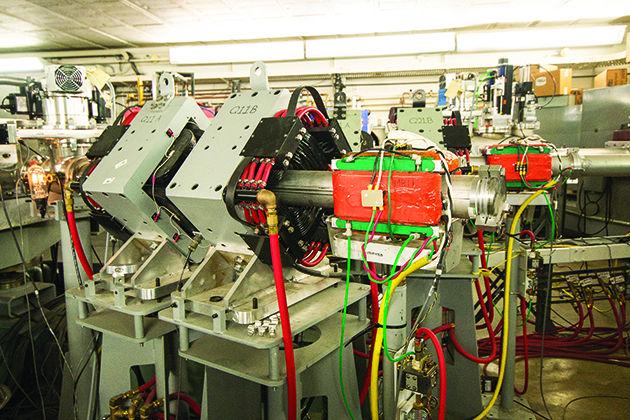Hidden from the rest of Texas A&M’s campus by four-foot-thick cement walls lies machines capable of moving atomic particles close to the speed of light.
The Cyclotron Institute houses two massive particle accelerators at its building across from the Zachry Engineering Center. The institute’s interior is a jig-saw puzzle of cutting-edge science — cranes run the building’s full length to move car-sized machinery and equipment, and large metal pipes connect the multi-ton cyclotrons to laboratories that use a stream of generated particles to research topics ranging from satellite technology to astrophysics.
“Nuclear physics is big toys for big boys,” said Henry Clark, accelerator physicist at the Institute. “To study the smallest things in the universe you need the biggest toys.”
The Cyclotron Institute and its machines are in high demand for both researchers and industry, placing Texas A&M at the forefront of particle physics research. With hands-on applications in fields such as astrophysics, chip testing and medical cures, these machines are progressing forward with Big Science.
The institute receives most of its funding from space technology research. Companies buy time on one of the accelerators to test how computer chips designed for space satellites react to the radiation levels present in orbit.
“So the engineers have to come here and they have to study all the components that go up into these satellites,” Clark said. “It is a huge program here. It is a huge income maker for the laboratories as well. We sell the beam time to these aerospace companies. Everyone comes here to do these kinds of tests on their electronics before they ever fly them in space.”
Companies that rely on Cyclotron Institute for testing include Boeing, Texas Instruments and Lockheed Martin. Yennello said NASA took up 261 hours of beam time alone last year.
Engineers from Lockheed Martin did 72 hours of testing at the institute for the computer chips that will be used on future deep-space missions, said Eldon Beach, a radiation effects testing analysis engineer at Lockheed Martin.
“This place runs 24 hours a day, and there is a high demand to get in here,” Beach said. “The whole space industry needs to come here
The Cyclotron Institute allows close collaboration between theory and experiment, a research perk easily seen in one of the institute’s main projects — astrophysics. A big part of the Texas A&M’s cyclotron research looks at what happened to the first particles at the beginning of the universe, Clark said.
“What our machines are good at studying is what happened when matter was formed together and created the stars and the planets and what happened over those years when it first evolved,” Clark said. “What we study is how these nuclei are formed — how long do they live, what happens when they interact with each other — because it tells us what happens in the stars.”
In addition to astrophysics, the machines are used in coordination with the vet school to create medical isotopes that are proven to cure lymphoma. By using the cyclotrons, they are able to convert certain particles that are necessary with the cure, Clark said.
“Just recently we had a presentation from a Russian group that is working on making medical isotopes for treatment of cancer and diagnostics of various diseases,” said Ethan Henderson, a physics graduate student.
Students are also able to gain practical, hands-on experience in the field of particle physics.
“We have about three dozen graduate students who are doing their PhD thesis research here,” said Sherry Yennello, Cyclotron Institute director. “There are also undergraduates that are involved in research — those are the people that are here all the time.”
Students that are here are able to build their projects from the ground up, Henderson said. Starting with calculations, students are then able to progress into building equipment for the project and are able to run the actual experiment.
The institute runs 24 hours per day, seven days per week.
“The demand on the cyclotrons is so much — we have such unique machines for doing not only basic nuclear physics but also applied physics — that we are under all kinds of stress at all times for people to come in,” Clark said.
Cyclotron accelerates A&M to research forefront
October 21, 2014
Tanner Garza — THE BATTALION
Two massive particle accelerators are housed across from the Zachry Engineering Center.
Donate to The Battalion
Your donation will support the student journalists of Texas A&M University - College Station. Your contribution will allow us to purchase equipment and cover our annual website hosting costs.























